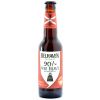Belhaven Brewery - Wee Heavy
-
ABV:
7.4% -
Bottle Size:
330-ml -
Int’l Bittering Units (IBUs):
16 -
Serving Temperature:
47-52° F -
Suggested Glassware:
Thistle, Tulip, Snifter -
Malts:
Pale, Black -
Hops:
Challenger, Golding
The "90/-" notation on the bottle of Belhaven's Wee Heavy is a nod to the now-obsolete shilling coinage, which was at one time the de facto method of rating the strength of Scottish beers, which were naturally more expensive the stronger they were. Beers could be rated as low as 60/- all the way up to 140/- or more, but around 90/- is generally where we get into the style known as Wee Heavy or Scotch Ale, a strong, malty, and often somewhat smoky brew reminiscent in some respects to Islay Scotch whisky.
Belhaven's Wee Heavy pours an attractive deep reddish-amber hue with a crop of light tan foam. On the nose, look for notes of caramel, biscuit, and hints of toffee, with an earthy, lightly peaty impression. The aroma predicts the flavor well – we picked up notes of caramel and light toffee, light toasty notes, and a touch of smoke, with a bit of opening sweetness that's dried out nicely with a balancing note of hop bitterness in the finish. For Scotch Ale food pairings, we like to go with dishes that will play well with the beer's maltiness. Lamb chops or game meats are a good call, especially with a lightly sweet pan sauce, as is smoked salmon, roasted pork, or desserts featuring caramelized sugar, such as crème brûlée. Cheers!
The oldest surviving brewery in Scotland (and one of the oldest in the whole U.K.), Belhaven Brewery’s roots as a commercial brewery go back all the way to 1719. However, it’s widely believed by historians that brewing operations have been going on at the site since at least the Middle Ages. Two wells and some of the brewery’s cellars are definitely at least as old as the 15th century, and there is reliable evidence that the wells were created in 1415 by Benedictine monks. The monks had been given the Isle of May in the Firth of Forth by Scottish King David I in 1150, and it was here that the Benedictines began the brewing legacy that would become Belhaven.
Over the next few hundred years, the monks colonized Fife and the Lothians, and eventually received lands near Dunbar at the harbor of Bele, known today as Belhaven. The Benedictine, or “blessed” order, was indeed quite gifted in the art of brewing ale. The monks lived and worked for centuries at the Belhaven property, and so enduring was their presence that the site upon which Belhaven Brewery now sits became known as “Monk’s Croft.”
Brewing was well-established at the Belhaven site by the middle of the 16th century, with records even documenting that their ale was supplied to the Franco-Scottish army in the 1550s while it was garrisoned at Dunbar Castle, bent on invading England. Brewing for commercial sale began in 1719 when Belhaven came into the ownership of Mr. John Johnstone (the date was commemorated by being carved into a wooden support beam, which is still present in the brewery). The brewery remained in this one family’s hands for over 250 years while they solidified the styles, recipes, and legacy of this famous beer lovers’ (bel)haven. If you'd like more information about the Belhaven Brewery, check out www.belhaven.co.uk.

Unmatched Variety by style, brewery & country
Choose from Five different Beer Clubs offering unmatched variety by brewery,
country of origin, and beer style to suit your specific tastes.


